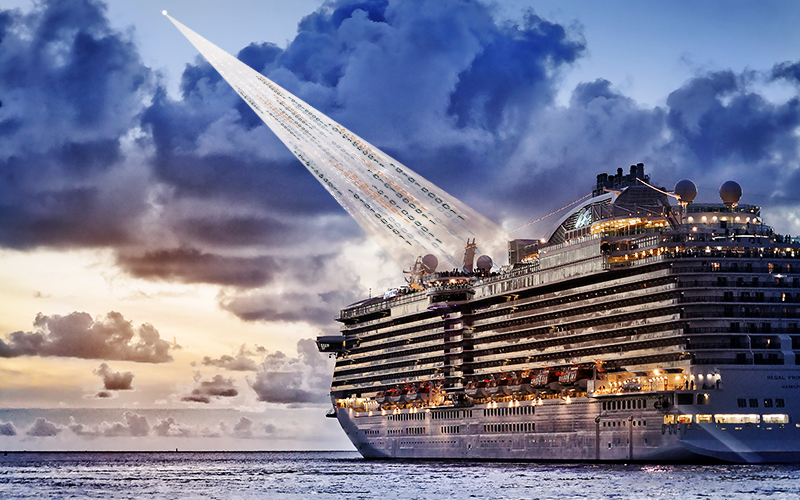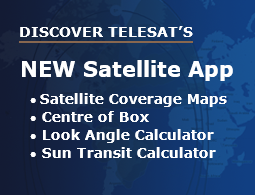Internet connectivity is now table stakes for travelers. They expect to share photos, videos, and communications in real-time with their friends and family, and the world via social media platforms. This point is underscored by Southwest Airlines’ recent announcement that it will invest US$2 billion to “modernize the customer experience,” with enhanced Wi-Fi connectivity at the top of its list.
The cruise industry is also trying to meet travelers’ expectations for reliable, high-speed connectivity. For example, Princess Cruises has been working for the past four-to-five years to “enable fleetwide, ubiquitous connectivity,” according to an interview with the operator’s president, John Padgett, recently published in Via Satellite.
Yet, Princess Cruises’ efforts are not the standard. Although cruise line operators are working to make ship connectivity less expensive and faster for their customers, in many cases it “might not be the seamless experience you’ve come to expect on land,” recently wrote travel blogger Gene Sloan.
That’s because it has, up until now, been difficult to address cruise connectivity challenges. Cruise ships continually traverse remote waters and locations without access to terrestrial networks and must rely on satellite-based offerings.
Passengers also bring multiple devices onboard — tablets, smartphones, laptops, wearable tracking devices — that they want to connect, driving up the need for additional bandwidth to the vessel. Meanwhile, ship operations and crews require connectivity as well. All these devices and applications quickly consume any available bandwidth, especially when there are as many as 8,000 passengers and 2,000 crew members onboard.
Blogger Sloan found that it is rare to achieve download speeds faster than 4 megabits per second (Mbps) onboard, writing that he experienced speeds as low as 1.5 Mbps. Although he was able to stream video services at that slower rate, he said it was “grainy” and sometimes ran into buffering problems. Those experiences aren’t acceptable to meet cruise passengers’ social connectivity needs, and certainly do not support the growing need for some passengers to do business while they cruise.
Ship-ready communications via satellite
Satellite connectivity in the cruise industry isn’t new. Satellite operators including Telesat have for years been providing Geostationary (GEO) capacity for cruise connectivity. However, these satellites are located 36,000 km from Earth, so the round-trip signal delay results in slow internet experiences. For this reason, several GEO satellite operators and service providers are adopting multi-orbit strategies to reduce latency and increase internet speeds.
Medium Earth Orbit (MEO) satellites are much closer to Earth versus GEO, but cannot provide coverage of all cruise routes including Alaska, Northern Europe, and the increasingly popular expedition cruises to the North and South Pole. For example, MEO satellites have limited to no coverage above 50º N and below 50º S, and no coverage at ±5º around the equator. That significantly reduces availability for cruise lines. This sort of inconsistent user experience results in passenger frustration.
Low Earth Orbit (LEO) satellites can make a difference in cruise line connectivity. They offer a significant advantage in terms of performance because they are 35x closer to Earth than GEO satellites. The result is that LEO satellites deliver approximately 20x lower latency with high speed for a fibre-like experience everywhere.
For example, the Telesat Lightspeed enterprise-class LEO network will deliver global, ubiquitous high-broadband density — up to 7.5 Gbps to a single antenna on the ship and hundreds of Gbps to vessels in high-demand hotspots like the Caribbean (over 600 Gbps) or Mediterranean (over 1,200 Gbps) oceans. This vast amount of capacity available for cruise ships will enable substantial improvements over the 3-4 Mbps speeds experienced by most cruise passengers today. As an enterprise-class network, Telesat Lightspeed customers will receive service level guarantees as opposed to a hit-or-miss best-effort service.
Cruise customers, like all consumers, expect the same connectivity experience that they achieve at home and work. The cruise industry is starting to recognize how LEO satellites will improve the onboard quality of experience and ensure their passengers are loyal, happy customers. Learn more about how Telesat Lightspeed delivers connectivity for commercial operations.




